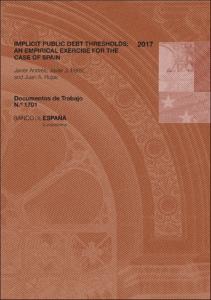Implicit public debt thresholds : an empirical exercise for the case of Spain
Authors
Issue Date
20-Jan-2017
Physical description
26 p. : gráficos
Abstract
Este artículo contribuye a la literatura que analiza los determinantes fundamentales de la dinámica de la deuda pública combinando modelos de vectores autoregresivos (VAR) y las ideas de la aproximación de Value at Risk. Los modelos que se estiman se usan para calcular la probabilidad de que la ratio de deuda pública sobre el PIB exceda un cierto umbral predeterminado de deuda, mediante simulaciones de Montecarlo. Se aplica la metodología al caso español, y se calculan de manera recursiva las series temporales de probabilidades y sus correlaciones con un indicador de riesgo de mercado (medido como el diferencial de rentabilidad del bono español a diez años con su equivalente alemán). A partir de estas correlaciones, se computa cuál sería el umbral de deuda para el que se maximizaría la correlación entre las dos variables (probabilidades y diferencial). El propósito de este ejercicio es calibrar el límite implícito de deuda o «nivel prudente de deuda pública» que refleja de manera más adecuada las expectativas del mercado, medidas por el diferencial de riesgo soberano. El nivel que se obtiene es coherente con la ratio de deuda pública sobre PIB del 60 % del PIB que actúa como ancla en el marco europeo de reglas fiscales
We extend previous work that combines the Value at Risk approach with estimation of the correlation pattern of the macroeconomic determinants of public debt dynamics by means of Vector Auto Regressions (VARs). These estimated models are used to compute the probability that the public debt ratio exceeds a given threshold, by means of MonteCarlo simulations. We apply this methodology to Spanish data and compute time-series probabilities to analyse the possible correlation with market risk assessment, measured by the spread over the German bond. Taking into account the high correlation between the probability of crossing a pre-specified debt threshold and the spread, we go a step further and ask what would be the threshold that maximises the correlation between the two variables. The aim of this exercise is to gauge the implicit debt threshold or “prudent debt level” that is most consistent with market expectations as measured by the sovereign yield spread. The level thus obtained is consistent with the medium-term debt-to-GDP ratio anchor of 60% of GDP
We extend previous work that combines the Value at Risk approach with estimation of the correlation pattern of the macroeconomic determinants of public debt dynamics by means of Vector Auto Regressions (VARs). These estimated models are used to compute the probability that the public debt ratio exceeds a given threshold, by means of MonteCarlo simulations. We apply this methodology to Spanish data and compute time-series probabilities to analyse the possible correlation with market risk assessment, measured by the spread over the German bond. Taking into account the high correlation between the probability of crossing a pre-specified debt threshold and the spread, we go a step further and ask what would be the threshold that maximises the correlation between the two variables. The aim of this exercise is to gauge the implicit debt threshold or “prudent debt level” that is most consistent with market expectations as measured by the sovereign yield spread. The level thus obtained is consistent with the medium-term debt-to-GDP ratio anchor of 60% of GDP
Notes
Incluye bibliografía
Publish on
Documentos de Trabajo / Banco de España, 1701
Subjects
Deuda pública; Indicadores de alerta temprana; Sostenibilidad de las finanzas públicas; Public debt; Early warning indicators; Fiscal sustainability; Déficit y deuda públicos; Política monetaria y deuda pública; España
Appears in Collections:












